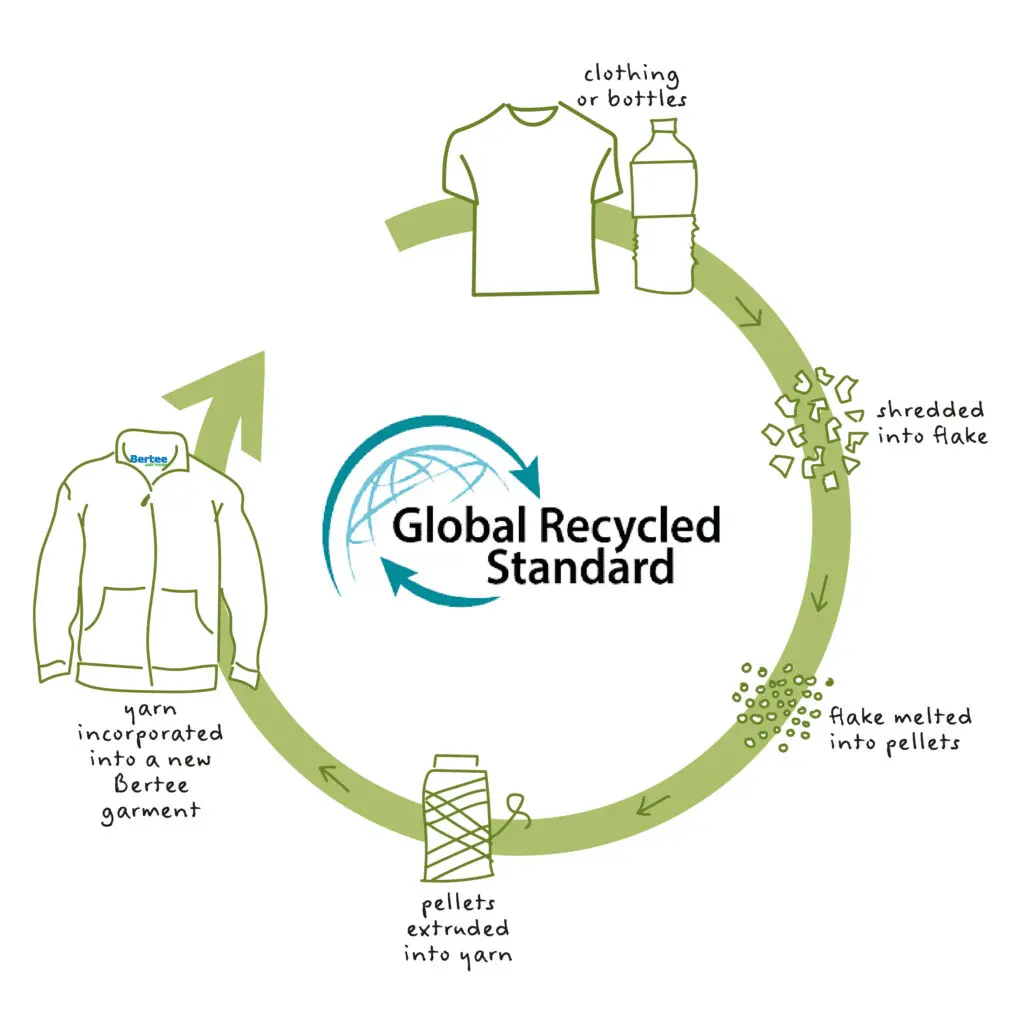Why Choose Eco-Friendly Workwear?
Environmental concerns have become a vital aspect of corporate social responsibility, with more businesses looking to ensure sustainability throughout internal operations and their supply chain. Making a conscious choice to select eco-friendly workwear is a great way to support your organisation’s sustainability goals.
Sustainable workwear protects people and planet using environmentally friendly materials (i.e., recycled and recyclable), and processes that focus on the well-being of all workers involved. This means there is a reduced impact on the environment – this includes the materials used, manufacturing process, and distribution methods.
Low-cost workwear will typically be less sustainable and may even be more expensive in the long run – this is because cheaper materials and production methods will lead to lower quality garments, meaning you’ll have to replace them more often. Therefore, sustainable workwear will often be more cost-effective for your business.
This white paper outlines the five key elements to consider when selecting sustainable workwear for your organisation.
1. What is the garment made from?
The range of eco-friendly workwear available is growing, and these garments are often made using recycled materials. One of the most common recycled materials you might see within sustainable workwear is recycled polyester, or rPET.
Recycled polyester is created by collecting post-consumer plastics, commonly PET plastic bottles or polyester clothing (either factory off cuts/waste or post-consumer textiles), that would otherwise go to landfill. The plastic is melted down and re-spun to create polyester yarn which can then be used to manufacture a range of textiles . The diagram below shows this process.

You might often see garments that are partially made of recycled materials – selecting those that are at least 50% recycled materials means you won’t be purchasing primarily non-recycled materials, which is more eco-friendly.
As well as recycled materials, you may want to select garments that are made from ethically sourced materials. For example, while leather does have a negative environmental impact, it is possible to find responsibly sourced leather to minimise harm to the planet. One way of selecting responsibly sourced leather is by checking for a LWG accreditation, which you can learn more about in the next section.
It’s important to look into the product specification to understand where the materials are derived from, and whether there is evidence to support its sustainable attributes.
2. Does the product/brand have the relevant accreditations?
Eco-friendly products should have the right accreditations to prove that they are sustainable. There are many trustworthy organisations that offer accreditation on an organisational or product level – for example, Textile Exchange. Textile Exchange facilitate many sustainability-focused accreditations, such as the Global Recycled Standard (GRS), and the Recycled Claim Standard (RCS). The GRS and RCS set the criteria for third-party chain of recycled materials. Textile Exchange trace recycled materials from source to seller, and all garments that meet requirements can be labelled with the RCS or GRS logo – this is what you should look for as it is evidence that the garment is made up of at least 50% recycled materials. You can find out more about Textile Exchange standards by clicking here.
As well as looking for recycled materials, you may want to check that materials have been ethically and sustainably sourced. The Leather Working Group (LWG) is a not-for-profit organisation that aims to create a more sustainable leather supply chain. LWG’s audit certification assesses leather manufacturing facilities (tanneries) on environmental compliance and performance in relation to water and energy usage; solid waste and effluent management; air and noise emissions; traceability; health and safety; chemical management; and restricted substances, compliance, and chromium VI (CrVI) management.
The process of turning animal hide into leather is known as ‘Tanning’. Chrome tanning is a common method of tanning and is carried out using sodium dichromate – this chemical is a carcinogen and can cause damage to the blood, kidneys, eyes, heart, and lungs. This is why it’s particularly important for LWG to assess management of chromium as it can cause health complications through contaminating water supplies, as well as burnt leather releasing the toxic chromium V1 into the atmosphere. Traditional vegetable tanning is, therefore, a more environmentally clean process. LWG also offer audits for leather traders and subcontractors, so you can trace sustainability through the supply chain. You can look for the LWG certification when purchasing workwear, especially footwear, made from leather to make more eco-friendly decisions. You can read more about the Leather Working group on their website.
Another way to look for more broad evidence of a brand or supplier’s sustainability practices is by checking for the ISO 14001 Environmental Management standard. This standard sets out the criteria for environmental management systems that include enhancement of environmental performance, fulfilment of compliance obligations, and achievement of environmental objectives. Companies can be certified to this standard and will often publish their environmental objectives. The standard can assure you that environmental impact is being measured and improved within the organisation, but it’s good practice to investigate the brand/supplier’s individual sustainability objectives (see number 4). To learn more about the ISO 14001 Environmental Management standard, you can refer to the International Organisation for Standardisation (ISO) website.
These three standards/accreditations are commonly used to prove the sustainable practices relating to workwear manufacture and supply, however, there are other standards you can look for. For example, the Global Organic Textile Standard (GOTS) assesses production and supply chain annually to ensure textiles are both organic and environmentally friendly. As well as checking for GOTS on the label, you can look for OEKO-TEX® who award certification for sustainable and responsible manufacture of garments, including individual standards for cotton and leather.
It’s vital that, while looking for sustainability accreditations, you ensure the product adheres to the correct safety standards for the work being carried out – workwear, safety wear and PPE should be fully compliant.
3. Are the distribution methods environmentally conscious?
Alongside textile composition, product distribution should be as eco-friendly as possible as a key aspect of a full-circle supply chain. This includes distribution across the entire supply chain, from raw material source, textile manufacture and garment construction, to customer delivery.
Locally manufactured products will typically be more sustainable when it comes to distribution, as the product will have less distance to travel to the end user. Despite this, it’s not always possible to source products locally. Distribution methods such as rail and sea are less harmful to the environment than road and air travel, however, this information may not be disclosed. You may want to locate a supplier local to you who use eco-friendly distribution methods such as electronic vehicles. This way the emissions are reduced, as well as the distance travelled from supplier to end user.
Non-recyclable plastic packaging is detrimental to the environment as it can take over 450 years to decompose (even then, they don’t fully disappear, they become microplastics) – these plastics either end up in landfill or the environment, commonly in oceans. Around 12% of plastic waste is incinerated, releasing potentially toxic substances into the atmosphere. If plastic is required for packaging, compostable plastics are a more sustainable alternative, though many of these biodegradable plastics can only be compostable in industrial conditions. Recyclable plastics can be used to create new packaging, which is a more sustainable option as it prevents the plastic going straight to landfill. Only 9% of plastic waste is recycled, however, so it’s best to avoid plastic packaging altogether where possible. If not avoidable, opt for a company that uses packaging that is both recycled and recyclable as energy consumption and C02 emissions are much lower in production of recycled plastics than virgin plastic (recycling plastic saves between 30% and 80% of the carbon emissions that original processing and manufacturing produces – Imperial College London).
Sustainable alternatives to plastic packaging include cornstarch packing peanuts; corrugated cardboard “bubble wrap”; recycled cardboard and paper; plastic-free packing tape or yarn, and even more innovative eco-packaging made from mushrooms or seaweed. Brands should be transparent about their packaging, and suppliers should maintain sustainable packaging methods when sending products to customers. Packaging elements should also be kept to a minimum, removing any unnecessary layers or boxes, while still protecting the product.
If you cannot find information about a product’s eco-friendly packaging or delivery methods online, you may want to contact the company or your supplier to discuss sustainable distribution.
4. Does the supplier have active internal sustainability initiatives?
When looking for sustainable workwear, it’s not just about the sustainable features of the product itself. You may want to ensure that the supplier you’re purchasing from are sustainability-focused, with goals towards supporting people and planet. By choosing a supplier who actively ensures sustainability throughout their supply chain, you can be sure that they’ll be able to offer you carefully selected eco-friendly products and offer support with your own business’ sustainability goals.
As well as a sustainable product range, suppliers may also have active eco-friendly initiatives that highlight their commitment to sustainability as an organisation. These initiatives may include:
- Recycling (this could be in relation to internal practice or a service for customers)
- Reduced packaging and/or plastic-free packaging
- Eco-friendly distribution (e.g., the use of electric vehicles)
- Customer environmental incentives (e.g., ‘for every £X amount you spend, we’ll plant X number of trees’)
- Use of energy-efficient lightbulbs
- Employee engagement with sustainability goals
Sustainability isn’t just about the environment; it also relates to ethical standards for those working to produce products. You should look out for the supplier’s statement on the Modern Slavery Act 2015. This will outline whether the supplier considers working conditions throughout their supply chain and establish good ethical practice to protect workers.
As previously mentioned, some suppliers adhere to the ISO 14001 Environmental Management standard – this is something you can look out for when researching an organisation’s sustainability practices and objectives.
5. Does the supplier offer garment recycling?
Selecting workwear made from sustainable materials is a great place to start, however, it’s also important to consider what will happen to the garment once you’re ready to dispose of it. Some suppliers may offer a recycling service, which stops your workwear going straight to landfill.
Recycling services allow you to have garment drop-off points held at your organisation for your employees to dispose of their old workwear. This can then be collected, sealed for transportation, and shredded at their secure shredding depots. Look for a supplier that offers a recycling service with a zero to landfill policy, which means garments are either recycled into new workwear or other items like building insulation. With some items this is not possible, but with a zero to landfill policy, these items will be turned into Refuse Derived Fuel, Solid Recovered Fuel, or go to an Energy from Waste Plant.
Garment recycling is another step towards a closed-loop sustainability system, which would involve recycling old garments into new garments. With mixed materials, recycling old garments into new garments is more complex. You can ask your supplier about ways they can help you to prevent your old workwear going straight to landfill.
With all of these things considered, you can begin to research environmentally friendly alternatives to your existing workwear, safety wear and PPE, and find a supplier who can help to support your organisation’s sustainability objectives.
STAY INFORMED
Keep yourself informed and compliant through PWS’ Knowledge Hub. Through this regularly updated resource, we aim to keep you updated with legislation, H&S information and white papers like this one.
To learn more about PWS’ environmental goals and initiatives, visit our Sustainability page.
